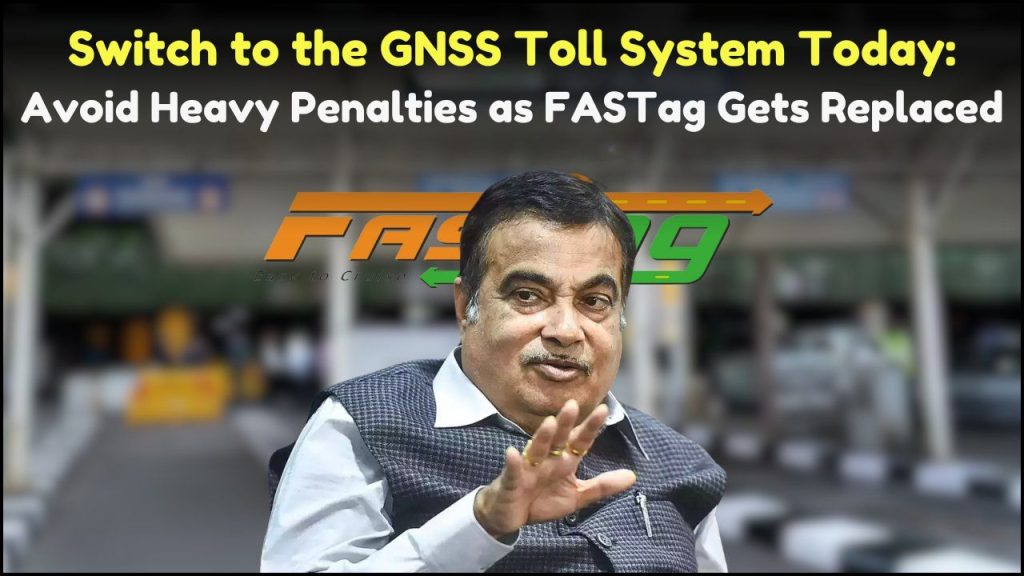
The Indian government has announced a major shift in the country’s toll collection infrastructure, replacing the widely used FASTag system with the advanced GNSS (Global Navigation Satellite System) Toll System. This transition marks a significant step forward in modernizing India’s transportation network and promises to transform how millions of vehicles navigate the country’s extensive roadways.
For vehicle owners across India, this change brings both opportunities and responsibilities. The new system will eliminate traditional toll booths, allowing for uninterrupted travel while automatically calculating toll charges based on actual road usage through satellite tracking. However, vehicle owners must take specific actions to ensure compliance with the new system to avoid penalties.
What is the GNSS Toll System?
The GNSS Toll System represents a fundamental shift in how toll collection works. Unlike FASTag, which relies on Radio Frequency Identification (RFID) technology requiring physical toll plazas, GNSS utilizes satellite technology to track vehicle movement across tolled roads automatically.
This system works by using satellite navigation to monitor a vehicle’s position in real-time. When a vehicle travels on a toll road, the GNSS device installed in the vehicle communicates with satellites to determine its precise location. This information is then transmitted to a central processing system, which calculates the appropriate toll charges based on the distance traveled and the specific toll rates for that road segment.
The key technological advantage lies in the elimination of physical infrastructure at toll points. Vehicles no longer need to slow down or stop at toll booths, creating a truly seamless travel experience while simultaneously improving traffic flow and reducing fuel consumption caused by frequent stopping and starting.
Core Features of the GNSS Toll System
The new satellite-based toll collection system comes with several innovative features that set it apart from traditional methods:
- Continuous Tracking: The system provides real-time monitoring of vehicle movement via satellite navigation, allowing for precise toll calculations.
- Automated Payment Processing: Toll charges are automatically deducted from linked payment methods without any manual intervention.
- Booth-Free Travel: The complete elimination of physical toll plazas ensures uninterrupted journeys and smoother traffic flow.
- Distance-Based Charging: Unlike fixed toll rates, the GNSS system can implement more equitable usage-based charging models.
- Data-Driven Road Management: The collected movement data can help authorities better understand traffic patterns and improve road infrastructure planning.
- Integration Potential: The system can potentially connect with other smart transportation systems for a more comprehensive urban mobility solution.
This technological upgrade positions India among forward-thinking nations embracing satellite-based toll collection systems, which have already proven successful in countries across Europe and parts of Asia.
Why India is Moving from FASTag to GNSS
While FASTag represented a significant improvement over cash transactions at toll plazas when it was introduced, it still maintains several inherent limitations that the GNSS system addresses:
Congestion Issues
Despite the improvements brought by FASTag, toll plazas continue to be bottlenecks for traffic flow. During peak travel periods, these areas still experience significant congestion as vehicles must slow down or stop completely for tag reading. The GNSS system eliminates these choke points by removing the need for physical toll collection points.
Scalability Concerns
As India’s road network continues to expand rapidly, adding physical toll infrastructure at every new toll point becomes increasingly costly and time-consuming. The GNSS system provides a scalable solution that can be implemented across the entire road network without requiring physical installation at each toll location.
Accuracy and Fairness in Charging
The FASTag system charges fixed rates regardless of the actual distance traveled on a tolled road. In contrast, GNSS allows for more precise distance-based charging, ensuring that road users pay only for their actual usage. This creates a fairer system where frequent travelers on shorter segments of toll roads aren’t disadvantaged.
Operational Efficiency
Maintaining physical toll plazas requires significant ongoing costs, including staffing, electricity, and maintenance. The GNSS system dramatically reduces these operational expenses while improving the efficiency of the entire toll collection process.
Environmental Benefits
By eliminating the need for vehicles to slow down and accelerate at toll plazas, the GNSS system contributes to reduced fuel consumption and lower carbon emissions, aligning with India’s broader environmental goals.
Essential Steps for Vehicle Owners
The transition to the GNSS Toll System requires vehicle owners to take several important actions to ensure compliance and avoid potential penalties:
1. Update Vehicle Registration Information
Ensure all vehicle registration details are current and accurate in the transport authority databases. This information will be linked to your GNSS account and is essential for proper identification and billing.
2. Install the Required GNSS Device
Vehicles will need to be equipped with a compatible GNSS-enabled device. These devices will likely be available through authorized service centers and designated distribution points. The government is expected to announce approved vendors and installation procedures.
3. Set Up Automated Payment Methods
Link your preferred payment method (credit card, debit card, or digital wallet) to your GNSS account to enable automatic toll deductions. Maintaining sufficient balance will be crucial to avoid payment failures and potential penalties.
4. Verify System Compatibility
Check whether your vehicle’s existing systems are compatible with the new GNSS technology. Newer vehicles may already have compatible systems, while older models might require additional equipment.
5. Register for the Official GNSS Portal or App
Create an account on the designated GNSS platform to monitor your toll usage, track expenses, and manage payment methods. This portal will likely serve as the central interface for all system-related activities.
6. Stay Informed About Deadlines
The government has established specific timelines for the transition. Vehicle owners should pay close attention to these deadlines to avoid non-compliance penalties, which could be substantial according to initial reports.
FASTag vs. GNSS: A Comprehensive Comparison
Understanding the differences between the existing FASTag system and the new GNSS system is crucial for appreciating the scale of this technological transition:
| Feature | FASTag | GNSS Toll System |
|---|---|---|
| Technology Used | Radio Frequency Identification (RFID) | Global Navigation Satellite System |
| Physical Infrastructure | Requires toll plazas with RFID readers | Simple tag attachment to the windshield |
| Vehicle Flow | Vehicles must slow down at toll plazas | Uninterrupted travel with no stopping required |
| Charging Model | Fixed charges per toll plaza | Potential for distance-based charging |
| User Experience | Improved over cash but still requires slowdowns | Completely seamless with no toll-related interruptions |
| Installation | Simple tag attachment to windshield | More complex device installation |
| Privacy Considerations | Limited tracking at toll points only | Continuous movement tracking during journeys |
| Maintenance Requirements | Minimal maintenance of RFID tag | Potential for more complex device maintenance |
| Data Collection | Limited to toll plaza crossings | Comprehensive movement data collection |
| Implementation Cost | Moderate infrastructure requirements | Higher initial setup costs |
GNSS Implementation Status Across India
The rollout of the GNSS Toll System is happening in phases across different states. Here’s the current implementation status across key regions:
| State | Road Network Coverage | Implementation Phase | Expected Completion |
|---|---|---|---|
| Maharashtra | Expressways and National Highways | Phase 1 – In Progress | Q4 2025 |
| Delhi NCR | Ring Roads and Urban Highways | Phase 2 – Upcoming | Q2 2026 |
| Karnataka | National Highways and State Expressways | Planning Stage | Q3 2026 |
| Tamil Nadu | State Highways and Urban Corridors | Phase 1 – In Progress | Q4 2025 |
| Gujarat | Major Intercity Routes and Port Connectivity | Phase 2 – Upcoming | Q1 2026 |
| West Bengal | Urban Roads and Highway Networks | Planning Stage | Q3 2026 |
| Rajasthan | Tourist Corridors and Desert Highways | Phase 1 – In Progress | Q4 2025 |
Challenges and Solutions in the Transition
While the GNSS Toll System offers numerous advantages, its implementation faces several significant challenges that must be addressed:
Infrastructure Development Costs
The initial investment required to establish the GNSS network and supporting systems is substantial. To address this, the government is reportedly exploring public-private partnership models and phased implementation strategies to distribute costs over time.
Technology Adoption Barriers
Many vehicle owners, particularly in rural areas, may face difficulties adapting to the new technology. The government plans to establish assistance centers and helplines to support users during the transition period.
Privacy and Data Security Concerns
The continuous tracking of vehicle movements raises legitimate privacy concerns. Authorities are working on robust data protection frameworks and anonymization techniques to safeguard user information while still maintaining system functionality.
System Reliability Issues
Satellite connectivity can be affected by various factors, including weather conditions and urban canyons. The system will likely incorporate backup mechanisms and fallback options to handle connectivity challenges in problem areas.
Government Initiatives to Ease the Transition
To facilitate a smooth transition from FASTag to GNSS, the government has announced several support initiatives:
Subsidy Programs
Early adopters of the GNSS system may qualify for government subsidies that offset a portion of the device installation costs. These programs aim to accelerate adoption rates and reduce financial barriers for vehicle owners.
Extended Transition Period
The government has reportedly established a grace period during which both FASTag and GNSS systems will operate concurrently, allowing vehicle owners sufficient time to make the switch without disrupting their travel plans.
Public Education Campaigns
Comprehensive awareness campaigns are being launched across various media channels to educate the public about the benefits and operational aspects of the new system. These initiatives include instructional videos, information kiosks at major transport hubs, and mobile outreach programs.
Industry Partnerships
Collaborations with vehicle manufacturers aim to integrate GNSS technology directly into new vehicles at the production stage. This factory-level integration will simplify the process for future vehicle owners and ensure optimal system compatibility.
The Future of Road Travel in India
The implementation of the GNSS Toll System represents more than just a change in toll collection methods—it signifies a fundamental shift toward smart transportation infrastructure. Looking ahead, this system could potentially integrate with other intelligent transportation initiatives:
- Traffic Management Systems: GNSS data could help optimize traffic signals and flow patterns in real-time.
- Emergency Response Coordination: Precise location data could improve response times for accidents and breakdowns.
- Dynamic Road Pricing: Toll rates could eventually adjust based on congestion levels, time of day, or air quality concerns.
- Connected Vehicle Ecosystems: The GNSS infrastructure could support vehicle-to-vehicle and vehicle-to-infrastructure communication.
As India embraces this technological leap, the country positions itself at the forefront of intelligent transportation systems in the developing world. The transition, while challenging, promises long-term benefits in efficiency, environmental impact, and overall travel experience for the millions who use India’s expanding road network every day.
Vehicle owners are strongly encouraged to prepare for this transition well before the mandatory implementation dates to avoid potential disruptions and penalties. By embracing this change proactively, road users can contribute to a smoother, more efficient transportation future for India.

Katherine Johnson is a passionate writer with a keen interest in storytelling, content creation, and creative expression. She enjoys exploring diverse topics and crafting engaging narratives that captivate readers.



